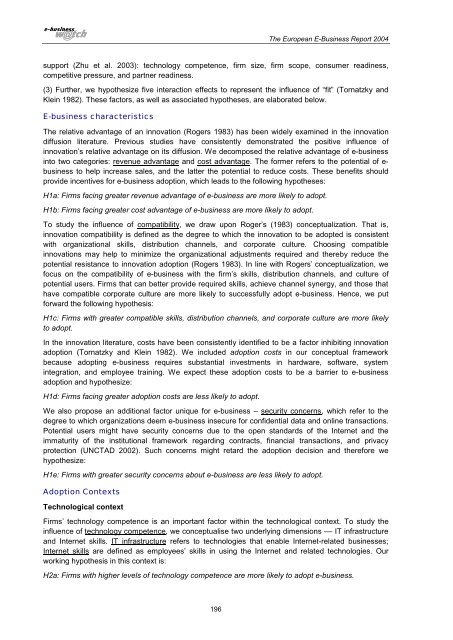The European e-Business Report 2004 - Berlecon Research GmbH
The European e-Business Report 2004 - Berlecon Research GmbH
The European e-Business Report 2004 - Berlecon Research GmbH
You also want an ePaper? Increase the reach of your titles
YUMPU automatically turns print PDFs into web optimized ePapers that Google loves.
<strong>The</strong> <strong>European</strong> E-<strong>Business</strong> <strong>Report</strong> <strong>2004</strong>support (Zhu et al. 2003): technology competence, firm size, firm scope, consumer readiness,competitive pressure, and partner readiness.(3) Further, we hypothesize five interaction effects to represent the influence of “fit” (Tornatzky andKlein 1982). <strong>The</strong>se factors, as well as associated hypotheses, are elaborated below.E-business characteristics<strong>The</strong> relative advantage of an innovation (Rogers 1983) has been widely examined in the innovationdiffusion literature. Previous studies have consistently demonstrated the positive influence ofinnovation’s relative advantage on its diffusion. We decomposed the relative advantage of e-businessinto two categories: revenue advantage and cost advantage. <strong>The</strong> former refers to the potential of e-business to help increase sales, and the latter the potential to reduce costs. <strong>The</strong>se benefits shouldprovide incentives for e-business adoption, which leads to the following hypotheses:H1a: Firms facing greater revenue advantage of e-business are more likely to adopt.H1b: Firms facing greater cost advantage of e-business are more likely to adopt.To study the influence of compatibility, we draw upon Roger’s (1983) conceptualization. That is,innovation compatibility is defined as the degree to which the innovation to be adopted is consistentwith organizational skills, distribution channels, and corporate culture. Choosing compatibleinnovations may help to minimize the organizational adjustments required and thereby reduce thepotential resistance to innovation adoption (Rogers 1983). In line with Rogers’conceptualization, wefocus on the compatibility of e-business with the firm’s skills, distribution channels, and culture ofpotential users. Firms that can better provide required skills, achieve channel synergy, and those thathave compatible corporate culture are more likely to successfully adopt e-business. Hence, we putforward the following hypothesis:H1c: Firms with greater compatible skills, distribution channels, and corporate culture are more likelyto adopt.In the innovation literature, costs have been consistently identified to be a factor inhibiting innovationadoption (Tornatzky and Klein 1982). We included adoption costs in our conceptual frameworkbecause adopting e-business requires substantial investments in hardware, software, systemintegration, and employee training. We expect these adoption costs to be a barrier to e-businessadoption and hypothesize:H1d: Firms facing greater adoption costs are less likely to adopt.We also propose an additional factor unique for e-business – security concerns, which refer to thedegree to which organizations deem e-business insecure for confidential data and online transactions.Potential users might have security concerns due to the open standards of the Internet and theimmaturity of the institutional framework regarding contracts, financial transactions, and privacyprotection (UNCTAD 2002). Such concerns might retard the adoption decision and therefore wehypothesize:H1e: Firms with greater security concerns about e-business are less likely to adopt.Adoption ContextsTechnological contextFirms’technology competence is an important factor within the technological context. To study theinfluence of technology competence, we conceptualise two underlying dimensions – – IT infrastructureand Internet skills. IT infrastructure refers to technologies that enable Internet-related businesses;Internet skills are defined as employees’skills in using the Internet and related technologies. Ourworking hypothesis in this context is:H2a: Firms with higher levels of technology competence are more likely to adopt e-business.196
















